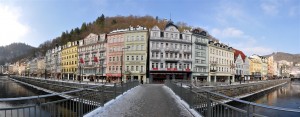Karlovy Vary [english: Carlsbad; german: Karlsbad], assumed to be founded by Charles IV, Holy Roman Emperor and Czech King around 1350, lies about 120 km west of Prague and 150 km south of Leipzig at the confluence of the rivers Ohre and Teplá. 20th largest city in the Czech Republic.
Population: 50.000 [2014] | 56.000 [1991] | 55.000 [1930]
Emperor Charles IV, who appraised the healing power of the hot springs in the area, gave city privileges to the town, which was subsequently named after him. From 1526 Bohemia including Karlovy Vary belonged to the Habsburg Monarchy. In the 18th and 19th century Karlsbad gained more and more importance as the foremost spa town in central europe. Its visitors included Tsar Peter the Great, Goethe, Karl Marx, Morzart, Richard Wagner, Atatürk, Bach, Beethoven and Sigmund Freud amongst others. After World War II the german majority population was expelled from Karlsbad and the Czech Republic. Since 1989 the city is regaining its former spa town status, attracting international tourists, especially a large number of russian visitors.
The Stara Louka (german: Alte Wiese which means old meadow) lies at the centre of the Spa Area of the city along the Teplá river. It is regarded its most picturesque street and main esplanade. Here the valley is very narrow and the hills start right behind these buildings with a popular viewpoint pavillon seen above. A little further to the left the Art Nouveau Grandhotel Pupp is situated on this street, the major setting of the James Bond movie „Casino Royale“.
Find more material from Karlovy Vary in our Czech Republic overview.
Click for larger view:
For classic view and more infos about the street (german link):
An alternative view of the Stara Louka as a classic panorama:
Another street view (work in progress) from Carlsbad:











